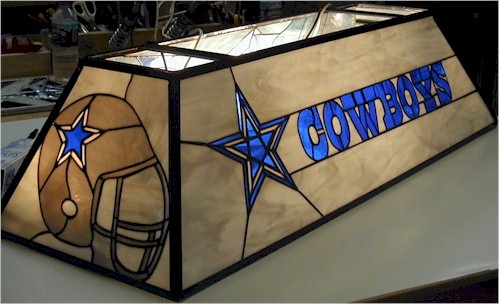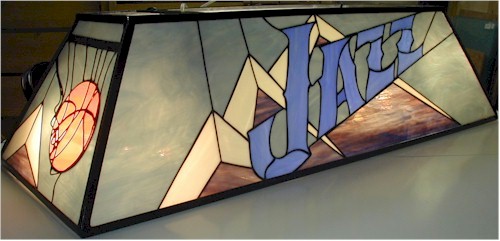Installing Art Glass In A Pool Table Lamp
We had a metalworking artist build a framework for a pool table lamp. It was a little tricky but not difficult to install the glass. We don't electrify lamps, because that would require U.L. listings and the costs for custom work would be prohibitive. What we do instead is call the lamp a "lamp shade" and allow local electricians to install whatever light package they desire. We sell the plans for our pool table lamp on ETSY (click here). You can take the plans to a welder you trust and have them build one for you.
Cut out poster board blanks that will fit into your frame and then build your glass to size. You don't want the glass too tight. It needs room to wiggle and have silicone all around the glass so it never makes contact with the metal.
Note: The long pieces go in first, they will cause the side pieces to have about 1/4" or more less room to go into the frame since the long side pieces will take up at least 1/8" on each side.
Cut out poster board blanks that will fit into your frame and then build your glass to size. You don't want the glass too tight. It needs room to wiggle and have silicone all around the glass so it never makes contact with the metal.
Note: The long pieces go in first, they will cause the side pieces to have about 1/4" or more less room to go into the frame since the long side pieces will take up at least 1/8" on each side.
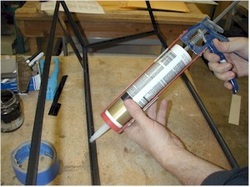
The panels are all built and sized to fit into the metal frame that I had built for the pool table lamp. After dry fitting each piece to make sure they would fit, I put a small bead of clear silicone caulk around the inside of the angle iron.
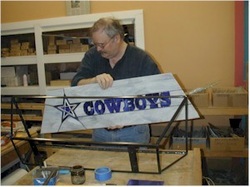
I have to gently ease the panel in place without allowing it to fold over since there are weaknesses in the glass design where the lead lines provide no support and depend on the frame they are going in for support.
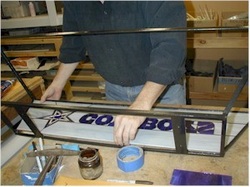
Once it's inside the frame, I gently lay it in place and center the gaps to be equal on each side. I'm careful not to let the glass hit the metal edges of the frame and chip.
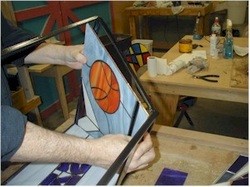
I then apply silicon to the inside of the side panel frame and ease the first side panel in place.
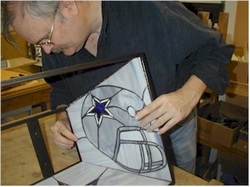
Same thing with the other side panel, add silicone and ease the panel in place. I have to be very careful not to allow too much pressure between the glass pieces. I even cut and grind some of the pieces so that the fit doesn't have too much pressure.
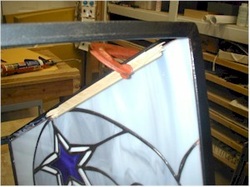
I take little strips of wood and c clamps to keep the glass tight against the frame, but I'm careful to only apply very gentle pressure. I don't want to crack my glass.
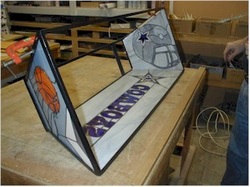
I let the framework sit for 24 hours so that the silicone can set and cure properly.
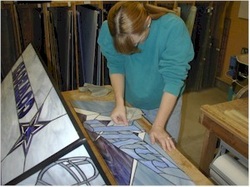
Here, Jeanne has just applied the black patina to the final panel and cleaned, waxed and polished it.
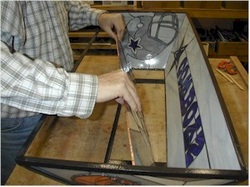
I stand the frame so gravity will work in my favor, remove extra sticks that were being used to clamp the panels and ease the final panel in place. I have to get the widest edge into the framework first and the pull the panel up into place so that the whole thing fits perfectly. I do it without silicone first so that I am sure it fits and then I bed it into the silicone.
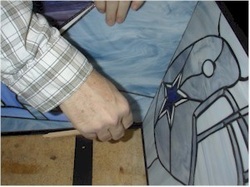
At each corner, I make sure there isn't any pressure against the glass and I add a bead of silicone between the panels to fill the slight gap between them. I make sure there is a little space between them because I don't want the glass edges to touch. If they do, heat expansion could cause them to expand and break each other. Silicone will protect against breakage.
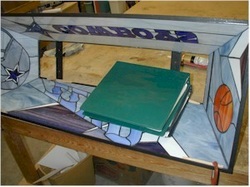
I put sticks and clamps against the final piece to hold it in place and I gently place a book on the panel to hold it against the frame where I can't easily get a clamp to fit. Once the silicone sets the glass fits well into the lamp and it's done.
Cowboys side and Jazz side look great. We've done other pool table lamps with other team logos.



